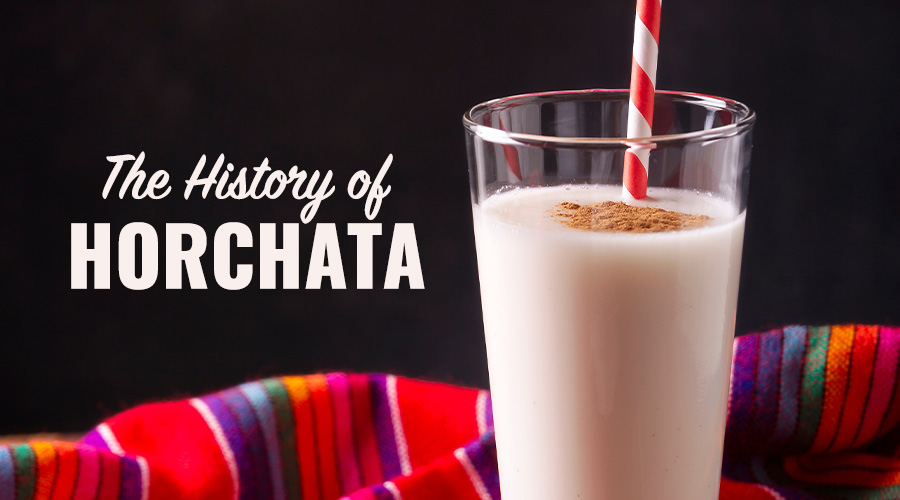
Horchata is a beloved beverage with a rich history, a drink whose origins are deeply rooted in ancient traditions, and over time, it has evolved into various regional variations enjoyed worldwide. In today’s blog, we’ll explore the fascinating history of horchata, from its early beginnings to its place in contemporary cuisine.
What is Horchata?
Horchata is a sweet, milky drink made from various plant-based ingredients. Here are a few common types:
- Mexican Horchata: The most well-known in the United States, Mexican horchata is made primarily from rice, milk, vanilla, and cinnamon. The rice is typically soaked and blended, then mixed with milk and flavored with vanilla and cinnamon, resulting in a creamy, sweet, and delicious drink.
- Spanish Horchata (Horchata de Chufa): In Spain, horchata is made from chufa (tiger nuts), water, and sugar. The tiger nuts are soaked, ground, and strained to produce a milky liquid that is sweetened to taste.
- Salvadoran Horchata: This variation often includes a mix of ground seeds and nuts, such as morro seeds, along with spices like cinnamon and vanilla. It might also contain ground sesame seeds, peanuts, and cashews, giving it a unique, nutty flavor.
- Other Regional Variations: There are numerous other regional variations of horchata throughout Latin America, each with unique ingredients and preparation methods. Some use barley, sesame seeds, or even coconut.
Horchata is typically served cold, making it a refreshing drink, especially in warm climates.

What is the History of Horchata?
Horchata began in ancient Egypt, where the first versions of the drink were made from tiger nuts, also known as chufa. These small tubers were cultivated along the Nile River and were prized for their sweet, nutty flavor and health benefits. The Egyptians would soak the chufa in water, grind them into a paste, and mix it with water to create a refreshing, milk-like beverage.
From Egypt, the knowledge of tiger nuts spread to the Iberian Peninsula through trade and conquest. The Moors, who ruled much of Spain from the 8th to the 15th century, adopted and adapted the drink. They called it “hordiat,” a term derived from the Latin word “hordeata,” meaning “made with barley,” though in this case, it referred to the chufa-based drink.
Horchata de Chufa: A Spanish Staple
In Spain, the drink became known as “horchata de chufa” and was immediately popular, particularly in the region of Valencia. The fertile soil of Valencia was ideal for cultivating chufa, which became a significant crop. The Spanish perfected the preparation of horchata de chufa, developing techniques that are still used today.
What’s in a Horchata? Sweetened Condensed Milk
Traditional horchata de chufa is made by soaking chufa nuts in water, grinding them, and then straining the mixture to extract a creamy, white liquid. This liquid is sweetened with sugar and flavored with cinnamon and lemon zest.
The Spread of Horchata to the Americas
With the Spanish colonization of the Americas, horchata de chufa made its way across the Atlantic. However, the new environment and the availability of different ingredients led to the evolution of horchata into new forms. In Mexico and other parts of Latin America, rice and other grains replaced chufa as the primary ingredient, giving rise to a distinct variation of the drink known as “horchata de arroz.”
Horchata de Arroz: The Mexican Twist with Rice and Cinnamon Sticks
In Mexico, horchata de arroz became a staple beverage. The preparation involves soaking rice in water, blending it with cinnamon sticks, and then straining the mixture in a liquid, with almond milk as a dairy-free option. Some variations also include sweetened condensed milk to add creaminess and enhance the overall taste. The drink is sweetened with sugar and flavored with vanilla or almonds. This version of horchata is often served over ice and pairs perfectly with spicy Mexican cuisine.
Horchata de arroz spread throughout Latin America, each region adding its own unique twist. In El Salvador, for example, the drink is often made with morro seeds, while in Honduras, it may include toasted sesame seeds. Despite these regional variations, the essence of horchata as a refreshing, sweet beverage remains constant.
Cultural Significance and Modern Popularity of Cinnamon Flavor
Horchata has transcended its origins to become an integral part of the cultural fabric in many countries. In Spain, horchata de chufa is a symbol of Valencian heritage and is often enjoyed during festive occasions. The city of Alboraya, near Valencia, is renowned for its horchata production and hosts annual festivals celebrating the drink.
In Mexico and other Latin American countries, horchata is a ubiquitous presence at street markets, taquerias, and family gatherings. It is often served alongside other traditional beverages like tamarindo and jamaica (hibiscus tea), providing a sweet counterbalance to the flavors of savory dishes.

Horchata in the United States
In the United States, horchata has gained popularity, particularly in areas with large Hispanic communities. It is a common offering in Mexican restaurants and can be found in grocery stores, often in ready-to-drink form. The versatility of horchata has also inspired chefs and mixologists to experiment with it, creating horchata-flavored desserts, cocktails, and even coffee drinks.
Nutritional Benefits
Beyond its delightful taste, horchata offers several nutritional benefits. Traditional horchata de chufa is rich in vitamins E and C, minerals like phosphorus and magnesium, and healthy fats. It is also lactose-free and gluten-free, making it a suitable alternative for those with dietary restrictions. Horchata de arroz, while higher in carbohydrates, provides hydration and can be fortified with additional nutrients depending on the ingredients used.
The Future of Horchata
As horchata continues to gain international recognition, its future looks promising. The global trend toward healthier, plant-based beverages has led to increased interest in traditional drinks like horchata. New variations and adaptations are likely to emerge as people experiment with different
ingredients and techniques. The rise of horchata-flavored products, such as ice creams, cakes, and even beer, reflects its growing appeal beyond just a traditional drink.
Innovations and New Variations
Innovations in the food and beverage industry are introducing horchata to new audiences and contexts. Creative minds are reimagining horchata in various forms:
- Horchata Lattes: Combining horchata with espresso, creating a creamy, spiced coffee drink that has become a favorite in many coffee shops.
- Horchata Ice Cream: The flavors of horchata lend themselves beautifully to ice cream, providing a refreshing and sweet dessert option.
- Horchata Cocktails: Bartenders are incorporating horchata into cocktails, adding a creamy, nutty dimension to classic drinks like margaritas and mojitos. When in Houston, be sure to stop in at one of our Houston liquor stores and check out our variety of spirits to mix with your Horchata.
Horchata and Sustainability
As consumers become more conscious of sustainability, horchata is being recognized for its potential in this area. The cultivation of chufa, for instance, is environmentally friendly, requiring less water than other crops. Additionally, the versatility of rice and other plant-based ingredients used in horchata aligns with the growing demand for sustainable food practices.
How Do You Make a Homemade Horchata Recipe?
For those who enjoy experimenting in the kitchen, making an authentic horchata recipe at home is a rewarding experience. Here is a simple recipe for a homemade horchata recipe de arroz:
Ingredients:
- 1 cup long-grain white rice and 1 cinnamon stick
- 4 cups water, divided
- ½ cup sugar (adjust to taste)
- 1 teaspoon vanilla extract
- Ground cinnamon, for garnish
Instructions:
- Rinse the rice under cold water and drain.
- In a blender, combine the rice, cinnamon stick, and 2 cups of water. Blend until the rice and cinnamon stick are broken down, about 1 minute.
- Transfer the mixture to a bowl, add the remaining 2 cups of water, and let it soak for at least 3 hours or overnight.
- Blend the soaked mixture again until smooth. Strain through a fine-mesh sieve, cheesecloth, or nut milk bag into a pitcher.
- Stir in the sugar and vanilla extract until the sugar is dissolved, ensuring the cinnamon flavor is well incorporated.
- Chill the horchata in the refrigerator. Serve over ice, garnished with a sprinkle of ground cinnamon.
This horchata recipe is perfect for serving over ice, garnished with a sprinkle of ground cinnamon.

Horchata: A Celebration of Tradition and Innovation
The history of horchata is a testament to the enduring appeal of this versatile beverage. From its ancient origins in Egypt to its transformation and spread across Spain, Latin America, and beyond, horchata has continually adapted while maintaining its essence as a refreshing, sweet drink.
In contemporary times, horchata continues to evolve, finding new expressions in culinary innovations and sustainable practices. Its rich cultural heritage and health benefits make it a beloved drink that bridges past and present, tradition and modernity.
As we celebrate horchata’s journey through history, we also look forward to its future, where it will undoubtedly continue to delight and refresh people around the world. Whether enjoyed in its classic form or as a creative new variation, horchata remains a drink that brings joy and a sense of connection to its rich and varied heritage.
Horchata is more than just a beverage; it is a cultural icon with a story that spans thousands of years. From its humble beginnings with ancient Egyptians to its modern-day variations, horchata has demonstrated an incredible ability to adapt and thrive. Whether you are sipping a glass of traditional horchata de chufa in Valencia, enjoying a horchata latte at a trendy café, or making your own horchata de arroz at home, you are partaking in a rich tradition that continues to evolve and inspire. So, next time you raise a glass of horchata, take a moment to appreciate its storied past and its bright future.
Horchata is a traditional drink originating from Spain and Latin America, typically made from ground almonds, rice, or tiger nuts, mixed with water and sweetened with sugar. It’s often flavored with cinnamon and sometimes includes other ingredients like vanilla or lime zest.
Horchata has roots in Valencia, Spain, where it was originally made with chufa (tiger nuts). However, variations of horchata are found across Latin America, with each region having its own unique recipe and ingredients.
Horchata has a creamy texture with a sweet and nutty flavor, often complemented by hints of cinnamon and other spices. The taste can vary depending on the ingredients used and regional variations.
Traditional horchata recipes are dairy-free as they typically do not contain milk. Instead, they rely on ingredients like rice, almonds, or tiger nuts for creaminess.
Horchata is made by soaking ground almonds, rice, or tiger nuts in water, often overnight. The mixture is then blended, strained, and sweetened with sugar. Cinnamon and other flavorings may be added, and the drink is served chilled over ice.
Horchata can be a refreshing and hydrating beverage, especially when made with wholesome ingredients like almonds or rice. However, it’s often sweetened with sugar, so it’s best enjoyed in moderation.
While traditional horchata is non-alcoholic, some variations, particularly in Mexico, incorporate alcohol. For example, “Horchata de Arroz con Rum” includes rum as an ingredient, providing a boozy twist to the classic drink.
Yes, there are various types of horchata based on regional preferences and available ingredients. For instance, horchata de chufa (made with tiger nuts) is popular in Spain, while horchata de arroz (made with rice) is more common in Latin America.
While horchata is traditionally served cold over ice, some people enjoy heating it and serving it warm, especially during colder months. Warm horchata can be a comforting alternative to hot beverages like cocoa or tea.
Yes, horchata is often vegan-friendly as it typically does not contain any animal products. However, it’s essential to check the ingredients, especially if purchasing commercially produced horchata, as some varieties may include additives or thickeners that are not vegan.




